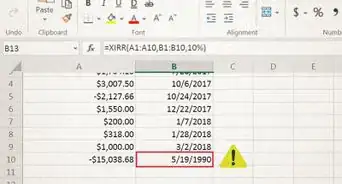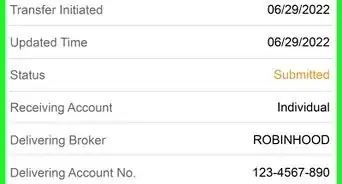This article was co-authored by Erin A. Hadley, CFP®. Erin A. Hadley is the Managing Partner at Occidental Asset Management, LLC in California. Erin is a Certified Financial Planner with over 10 years of experience in investment management and financial planning. She has a Certificate in Personal Financial Planning from the University of California, Berkeley and is a member of The National Association of Personal Finance Advisors (NAPFA).
There are 7 references cited in this article, which can be found at the bottom of the page.
wikiHow marks an article as reader-approved once it receives enough positive feedback. In this case, 97% of readers who voted found the article helpful, earning it our reader-approved status.
This article has been viewed 255,383 times.
Creating a viable investment plan requires a little more than simply establishing a savings account and buying a few random shares of stocks. In order to structure a plan that is right, it's important to understand where you're at and what you want to accomplish with the investments. Then, you'll define how to reach those goals and select the best investment options to reach them. The good news is that it is never too late to create and implement a personal investment plan and begin creating a nest egg for the future.
Steps
Assessing Where You're At
-
1Select an age-appropriate investment option. Your age will have a significant impact on your investment strategy.
- Generally speaking, the younger you are, the more risk you can take. That's because you have more time to recover from a market downturn or loss of value in a particular investment. So, if you're in your 20's, you can allocate more of your portfolio to more aggressive investments (like growth-oriented and small-cap companies for example).
- If you're nearing retirement, allocate more of your portfolio to less aggressive investments, like fixed-income, and large-cap value companies.
-
2Understand your current financial situation. Be aware of how much disposable income you have available to invest. Take a look at your budget and determine how much money is left over for investments following your monthly expenses and after you have set aside an emergency fund equivalent to three to 6 months' worth of expenses.Advertisement
-
3Develop your risk profile. Your risk profile determines how much risk you're willing to take.[1] Even if you're young, you might not want to take a lot of risks. You'll select your investments based on your risk profile.
- Generally speaking, stocks are more volatile than bonds, and bank accounts (checking and savings accounts) are not volatile.[2]
- Remember, there are always risk trade-off's to be made. Often, when you take less risk, you make less. Investors are richly rewarded for taking significant risks, but they can also face steep losses.[3]
Establishing Your Goals
-
1Set goals for your investments. What do you want to do with the money you make from your investments? Do you want to retire early? Do you want to buy a nice house? Do you want a boat?[4]
- As a rule of thumb, you're going to want a diversified portfolio no matter what your goal is (buying a house, saving for a child's college education, etc.). The idea is to let the investment grow over a long period of time so that you have enough to pay for the goal.
- If your goal is particularly aggressive, you should put more money in the investment periodically rather than opting for a more risky investment. That way, you're more likely to achieve your goal rather than lose the money that you've invested.
-
2Establish a timeline for your goals. How soon do you want to reach your financial goals? That will determine the type of investments you make.
- If you're interested in getting a great return on your investment quickly, and you are prepared to take the risk that you could also see a great loss just as quickly, then you'll select more aggressive investments that have the potential for significant return. These include undervalued stocks, penny stocks, and land that might quickly appreciate in value.
- If you're interested in building wealth slowly, you'll select investments that generate a slower return on investment over time.
-
3Determine the level of liquidity you want. A "liquid" asset is defined as an asset that can be easily converted to cash. That way, you'll have quick access to the money if you need it in an emergency.[5]
- Stocks and mutual funds are very liquid and can be converted into cash, usually in a matter of days.
- Real estate is not very liquid. It usually takes weeks or months to convert a property to cash.
Creating the Plan
-
1Decide on how you want to diversify. You don't want to put all your eggs in one basket. For example: Every month, you might want to put 30% of your investment money into stocks, another 30% into bonds, and the remaining 40% into a savings account. Adjust those percentages and investment options so that they're in line with your financial goals.
-
2Ensure that your plan is in line with your risk profile. If you put 90% of your disposable income into stocks every month, then you're going to lose a lot of money if the stock market crashes. That might be a risk that you're willing to take, but be sure that's the case.
-
3Consult a financial adviser. If you're uncertain about how to set up a plan in line with your goals and your risk profile, talk to a qualified financial adviser and get some feedback.[6]
-
4Investigate your options. There are many different accounts you might use for an investment plan. Familiarize yourself with some of the basics and figure out what works for you.
- Set up a short-term emergency savings account with three to six months worth of living expenses. It's important to have this established to protect yourself if something unexpected happens (job loss, injury or illness, etc.). This money should easy to access in a hurry.
- Consider your options for long-term savings. If you are thinking about saving up for retirement, you may want to set up an IRA or 401(k). Your employer may offer a 401(k) plan in which they will match your contribution.
- If you want to start an education fund, think about 529 plans and Education Savings Accounts (ESAs). Earnings from these accounts are free from federal income tax as long as they’re used to pay for qualified education expenses.[7]
Evaluating Your Progress
-
1Monitor your investments from time to time. Check to see if they're performing according to your goals. If not, reevaluate your investments and determine where changes need to be made.
-
2Determine if you need to change your risk profile. Generally speaking, as you get older, you'll want to take less risk. Be sure to adjust your investments accordingly.
- If you have money in risky investments, it's a good idea to sell them and move the money to more stable investments when you get older.
- If your finances tolerate the volatility of your portfolio very well, you might want to take on even more risk so that you can reach your goals sooner.
-
3Evaluate whether or not you're contributing enough to reach your financial goals. It may be the case that you're not putting enough money from every paycheck into your investments to make your goals. On a more positive note, you might find that you're way ahead of reaching your goals and that you're putting too much money into your investments on a regular basis. In either case, adjust your contributions accordingly.
References
- ↑ http://www.investopedia.com/articles/pf/07/risk_tolerance.asp
- ↑ http://classroom.synonym.com/investing-stocks-bonds-riskier-saving-money-bank-16121.html
- ↑ http://www.investopedia.com/terms/r/riskreturntradeoff.asp
- ↑ http://www.schwab.com/public/schwab/investing/retirement_and_planning/how_to_invest/investing_basics/set_your_goals
- ↑ http://www.investopedia.com/terms/l/liquidity.asp
- ↑ http://money.usnews.com/money/personal-finance/financial-advisors/articles/2014/02/26/how-to-find-a-financial-advisor-if-youre-not-rich
- ↑ http://www.schwab.com/public/schwab/investing/retirement_and_planning/saving_for_college/college_savings_plans
About This Article
Creating a solid investment plan will help your assets mature at a rate that suits your personal needs. If you’re young and prepared to take more risk, invest in more aggressive assets like stocks in growth-oriented and small-cap companies. For a safer option, allocate more of your portfolio to less aggressive investments, like fixed-income, and large-cap value companies. If you only want the money for retirement, consider investing in an IRA or 401(k). It’s always a good idea to diversify your portfolio to minimize your risk. For example, split your investment money between stocks, bonds, and savings accounts. You should also keep an emergency savings account with 3 to 6 months of living expenses in case of a big financial hit like losing your job. For more tips from our Financial co-author, including how to adjust your investment portfolio over time, read on!











-Step-1.webp)































































